Key Scottish Environment Statistics 2015
This publication aims to provide an easily accessible reference document which offers information on a wide range of environmental topics. It covers key datasets on the state of the environment in Scotland, with an emphasis on the trends over time wherever possible. The data are supplemented by text providing brief background information on environmental impacts and data source, a summary of the trend and brief information on the potential factors affecting the trend.
Global Atmosphere
Background
Changes in the amount of energy retained within the atmosphere affect the global climate, which naturally exhibits long-term fluctuations. However, "human influence on the climate system is clear" and it is extremely likely that over half of the observed increase in global average surface temperature from 1951 to 2010 was due to human activities.[20] This human influence has mainly been in the form of the emission of greenhouse gases, such as carbon dioxide (CO2), that help to trap heat within the atmosphere and so contribute to global warming. Atmospheric concentrations of CO2, methane and nitrous oxide are now at the highest levels for at least the last 800,000 years.[21]
Our Changing Climate
Global climate projections indicate that the global mean surface temperature will likely increase by between 0.3°C and 1.7°C based on a low emissions scenario, or by between 2.6°C and 4.8°C based on a high emissions scenario, by 2081-2100 relative to 1986-2005[21]. Global mean precipitation is also projected to increase with global warming, although this will vary spatially and seasonally. These changes have implications for a wide range of areas including health, agriculture and transport.
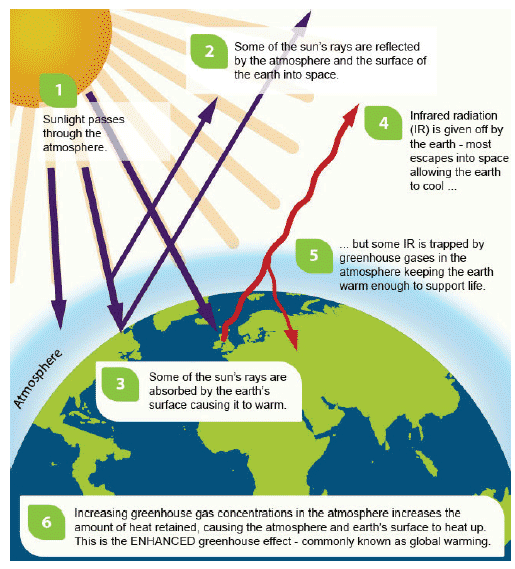
The greenhouse effect - from Scotland's Environment website, Get Informed section
Targets and Indicators
The Climate Change (Scotland) Act 2009[21] has set long term percentage reduction targets for the reduction of greenhouse gas emissions and also requires Scottish Ministers to set annual targets for emissions[22], [23].
Estimates of greenhouse gas emissions and carbon footprint are both reported to meet the requirements of the Climate Change (Scotland) Act 2009, and also inform a range of Scottish Government indicators, including:
- Scottish Government Sustainability Purpose Target[24]
- Scotland Performs National Indicator 47: Reduce Scotland's Carbon Footprint[25]
Annual Mean Temperature: 1910-2014
Annual mean temperature - difference from 1961-1990 average (degrees Celsius)[26]
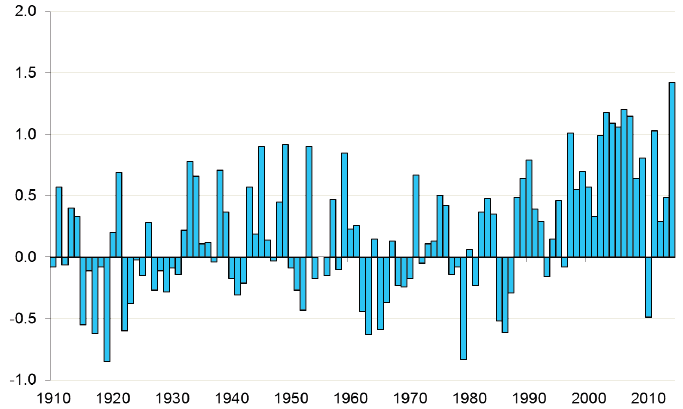
Why this measure is important
Temperatures in Scotland are projected to continue increasing over the next century, with a general trend towards hotter summers and milder winters[27]. The effects of rising temperatures have implications in areas such as health, agriculture, forestry, transport, water resources and energy demand. These are areas of economic, social and environmental importance.
Background
The Met Office gather air temperature measurements from a network of weather stations across Scotland. The figures are then interpolated to 5km grid points and averaged across Scotland.
Trend
Eight of the ten warmest years recorded in Scotland have all occurred in the 21st century. 2014 was the warmest year on record with a temperature of 8.45 °C (1.42°C higher than the 1961-1990 average), a 0.93 °C increase from 2013. The average temperature in the 2000's was 0.90 ºC warmer than the 1961-1990 average and warmer than any other decade.
Factors affecting trend
While the global climate naturally exhibits long-term fluctuations, there is evidence that humans are influencing the climate system[28]. This is mainly through the emission of greenhouse gases, a large proportion of which are generated through the combustion of fossil fuels.
Source: Met Office | Metadata
Annual Precipitation: 1910-2014
Annual precipitation as a percentage of 1961-1990 average[29]
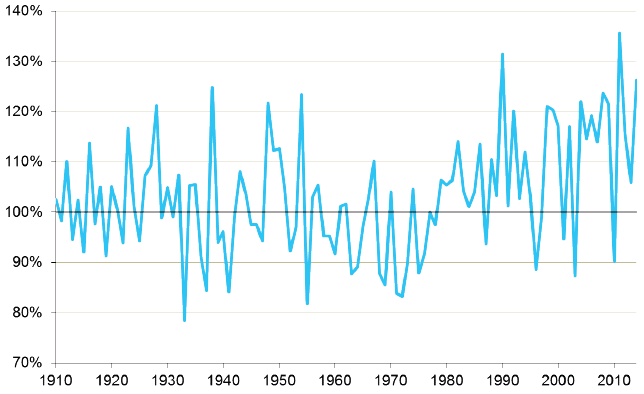
Why this measure is important
The UK Climate projections[30] indicate that the climate trends observed over the last century will continue and intensify over the coming decades. Rainfall is likely to become even more seasonal, with an average summer becoming drier, while autumn and winter become wetter[31]. Precipitation changes have several implications for Scotland, affecting water resources, flood and drought risk and habitat loss.
Background
Data are obtained from the Met Office. Measurements from rain gauges in the Met Office network of rainfall stations are interpolated to 5km grid points, and are then averaged across Scotland.
Trend
The average annual precipitation in the 1980s, 1990s and 2000s was higher than in previous decades. Annual precipitation in 2014 was 26.3% above the 1961-1990 baseline[32]. However, it is important to note that although there has been an overall increase in rainfall, this varies among seasons and regions.
Factors affecting trend
While the global climate naturally exhibits long-term fluctuations, there is evidence that humans are influencing the climate system[33]. This is mainly through the emission of greenhouse gases, a large proportion of which are generated through the combustion of fossil fuels.
Source: Met Office | Metadata
Greenhouse Gas Emissions by Source: 1990-2013R
Million tonnes carbon dioxide equivalent (MtCO2e)[34]
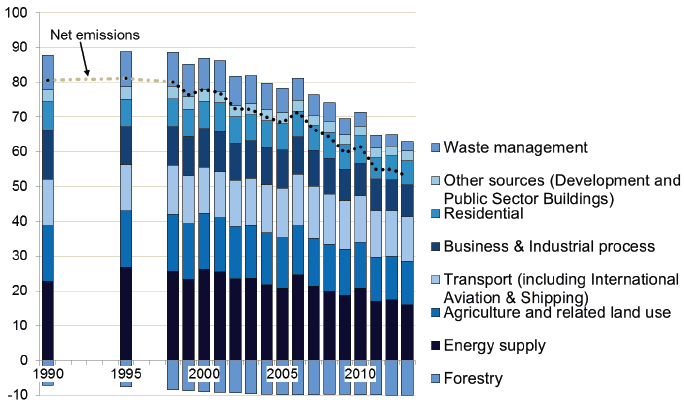
Why this measure is important
Greenhouse gases (GHGs) in the atmosphere help to retain radiative energy, resulting in warming of the lower atmosphere and earth surface.
Background
The Greenhouse Gas Inventory[35],[36] is compiled in line with international guidance from the Intergovernmental Panel on Climate Change (IPCC)[37]. Only anthropogenic emissions (i.e. those caused by human activity) are included.
Trend
Scotland's net emissions of greenhouse gases in 2013, including emissions from international aviation and shipping, were estimated to be 53.0 million tonnes of carbon dioxide equivalent (MtCO2e), 3.6% (2.0 MtCO2e) lower than 2012 and 34.3% below 1990 levels. Energy supply emissions rose 18% between 1990 and 1995 and have since fallen by 40% but remain the largest source of emissions in 2013 (16.0 MtCO2e). Other sectors with large falls in emissions between 1990 and 2013 include waste (-73%), business and industrial process (-36%) and agriculture and related land use (-23%). The size of the annual forestry sink rose by 42% between 1990 and 2013 to -10.0 MtCO2e in 2013.
Factors affecting trend
Waste emissions fell due to the reduction in biodegradable waste landfilled and increased capture of landfill gas. The closure of Ravenscraig steel works in 1992 resulted in a sharp fall in industrial process emissions. Energy supply emissions fell following reduced use of coal at power stations. Agriculture and related land use emissions primarily fell due to historic land use changes and changes in farming practices. The forestry sink rose as a result of afforestation in the 1960's and 1970's which increased the net carbon store.
Source: National Atmospheric Emissions Inventory / Scottish Government | Metadata
Scotland's Carbon Footprint (Greenhouse Gas Emissions on a Consumption Basis): 1998-2012R
Values in million tonnes carbon dioxide equivalent (MtCO2e)[38]
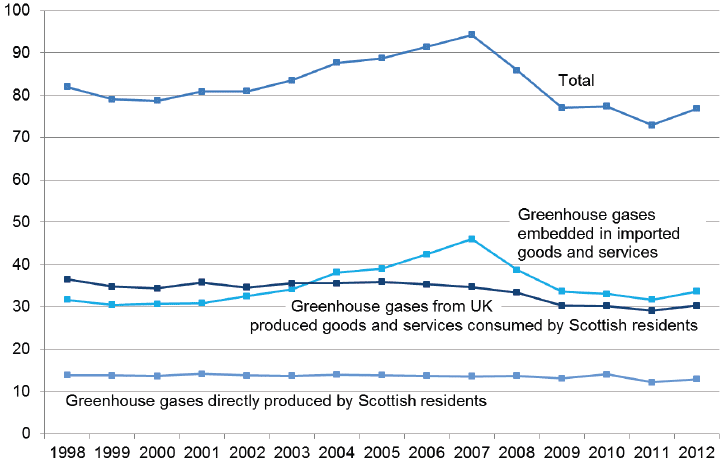
Why this measure is important
Scotland's carbon footprint[39] measures all greenhouse gas (GHG) emissions generated at home and abroad in the production and transport of the goods and services consumed by Scottish residents.
Background
Data are provided under contract from the University of Leeds using a Multi-Regional Input-Output (MRIO) model, which takes the GHG emissions from where goods are bought and their associated supply chains into account.
Trend
Between 1998 and 2012, Scotland's carbon footprint fell by 6.3 per cent, from 82.0 million tonnes carbon dioxide equivalent (MtCO2e) in 1998 to 76.8 MtCO2e in 2012. Scotland's carbon footprint rose fairly steadily from 1998 to a peak of 94.3 MtCO2e in 2007 before falling sharply in the following years to 77.1 MtCO2e in 2009 and 72.9 MtCO2e in 2011. Between 2011 and 2012, the total carbon footprint increased by 5.3 per cent. GHG emissions associated with imported goods and services increased from 31.7 MtCO2e in 1998 to 46.0 MtCO2e in 2007, before falling to 33.6 MtCO2e in 2012.
Factors affecting trend
Scotland's carbon footprint is partly affected by the economy (which can affect how much of the goods and services Scotland uses are imported from outside the UK) as is evidenced by the sharp decrease in carbon footprint after 2007, coinciding with the global recession.
Source: Scottish Government | Metadata
Column Ozone Measurements: 1981-2014
Column ozone concentrations over Lerwick (Dobson units)
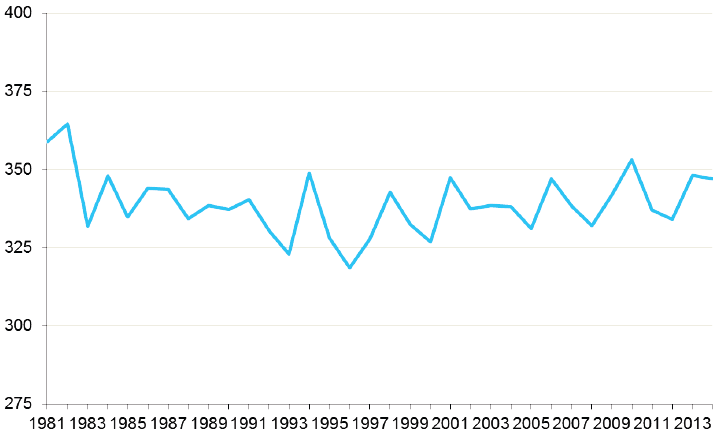
Why this measure is important
The stratospheric ozone layer, located around 10-30 km above the Earth's surface, forms a protective shield against harmful solar (UVB) radiation[40]. Thinning of the ozone layer has occurred since the beginning of the 1980s in all regions except those around the equator.
Background
Column ozone measurements are made using the Dobson Spectrophotometer at Lerwick in 4-year observational cycles.
Trend
The total ozone levels at Lerwick vary seasonally, with maximum levels generally occurring in early spring and minimum levels in autumn. Generally, levels decreased until the late 1990s. More recently, it appears that this trend may be leveling out, but it is too soon to be sure.
Factors affecting trend
Over the last 30 years, the annual average total ozone cover over Lerwick has shown the natural variability which would be expected due to varying meteorological conditions. Globally, the 1987 Montreal Protocol[41] set guidelines to eliminate the global production and use of ozone depleting substances. European production of CFCs for non-essential use fell to zero in 1995. However, leaks from old equipment and the long life of these substances mean that full recovery of the ozone layer is not predicted until about 2050.
Contact
Email: Kirsty Ciclitira
There is a problem
Thanks for your feedback